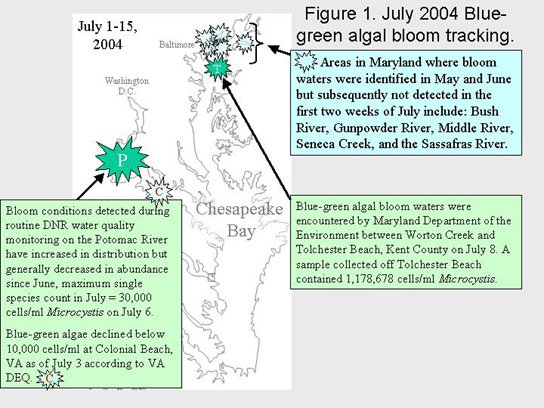|
||
Maryland Department of Natural Resources (DNR) and the Academy of Natural Sciences (ANSERC) identified blue-green algae that are widespread above the Route 301 Bridge to Mattawoman Creek (Potomac River) on July 6 but levels of Microcystis were typically below 10,000 cells/ml (Figure 1). Two exceptions were samples collected by ANSERC at the Mattawoman Boat Ramp (13,000 cells/ml Microcystis) and on the mainstem Potomac near Wellington Beach (30,000 cells/ml Microcystis) during routine water quality monitoring. Colonial Beach, VA, on the Potomac River had blue-green blooms that led to a beach closure before the July 4th holiday, however, the beach reopened July 3 with measurements of low algal concentrations. In Kent County, Maryland, Department of the Environment field personnel
collected a water sample from a blue-green algal bloom located off of
Tolchester Beach on July 8. A slick of algae was noted in the mainstem
Chesapeake Bay from Worton Creek down to the region of Tolchester Beach
(Figure 1). The water sample contained 1,178,678 cells/ml Microcystis and has been sent to Wright State University for microcystin toxin testing;
results are pending. 
Bush River, Sassafras River, Middle River, Gunpowder River and Seneca
Creek Pockets of blue-green algal blooms may be encountered during boating and other recreational activities. People should take common precautions to reduce the risk of illness or discomfort related to blue-green algal blooms:
Please note that illness associated with harmful algal blooms is now a reportable illness so physicians should be reporting these to local health departments. The MD DNR in coordination and cooperation with DHMH and MDE will continue to monitor all blue-green algal blooms throughout the state. For up to date information on all of Maryland's harmful algal blooms and water quality, please visit Eyes on the Bay |
